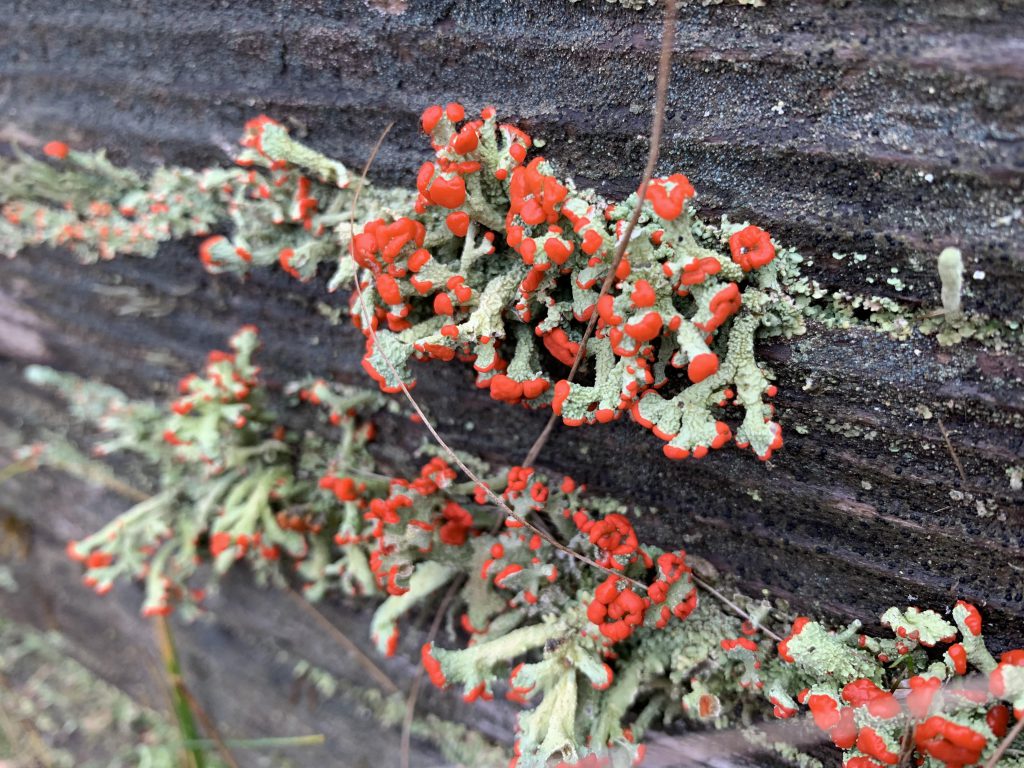
What is so tough that it can survive on bark, rocks, dirt, and even outer space? A little organism called lichen.
You might have seen it before: lichen is that flat, green or blue, flakey stuff on tree bark or rocks. Sometimes people think it’s moss, but it’s not. Actually, I wondered on my last walk, what exactly is this weird thing?
On this week’s virtual field trip, we’ll find out just what lichen is and what it does!
CHOOSE YOUR LICHEN ADVENTURE:
Attend the virtual field trip, Friday, January 8 at 10:30. We’ll find out what lichen is and how it can survive harsh places!
Learn what lichen is: Read and look at pictures of lichen.
Look for lichen outside: What kind can you find? Does it tell you anything about the ecosystem?
Virtual Field Trip, Jan. 8 at 10:30am
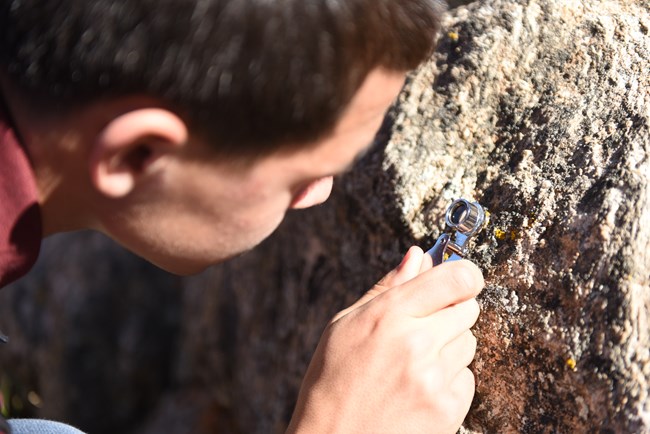
Every Friday from 10:30 to 11-ish am, we hold a Zoom call live from the woods for anyone who wants to join. This week, we’ll look at what lichen is, how it survives crazy conditions, and how you can recognize it!
If you haven’t registered for our field trips before, register here to get the link in your email:
The same link works each Friday.
What is lichen?
If you’ve ever noticed something that…
… is grey, blue-ish, green or lime green;
… growing off a tree, a rock, cement or just on the ground;
…looks like flakes
…then you might have seen a lichen! Here are pictures of common lichens here in southeast Ohio:
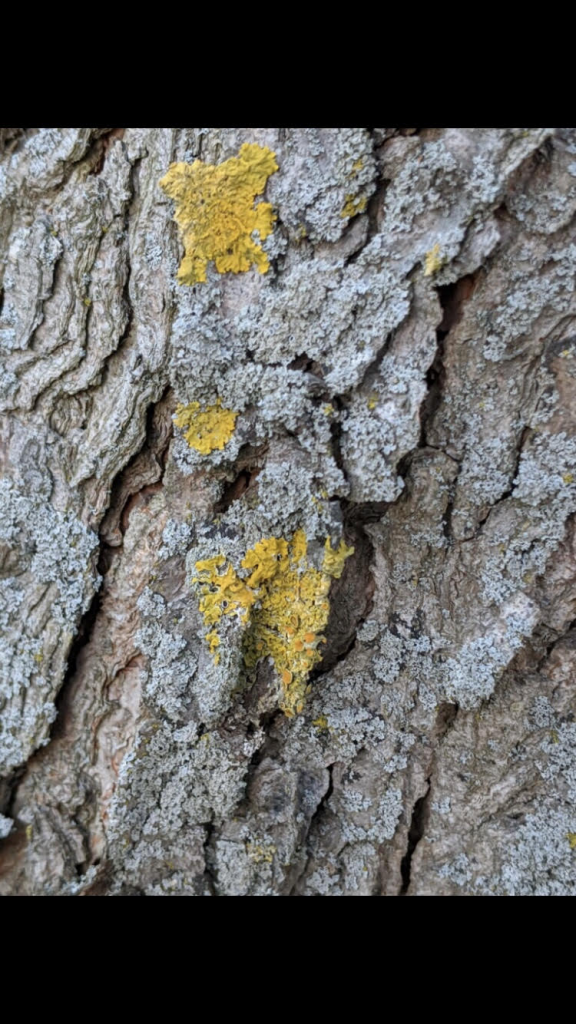
Common sunburst lichen 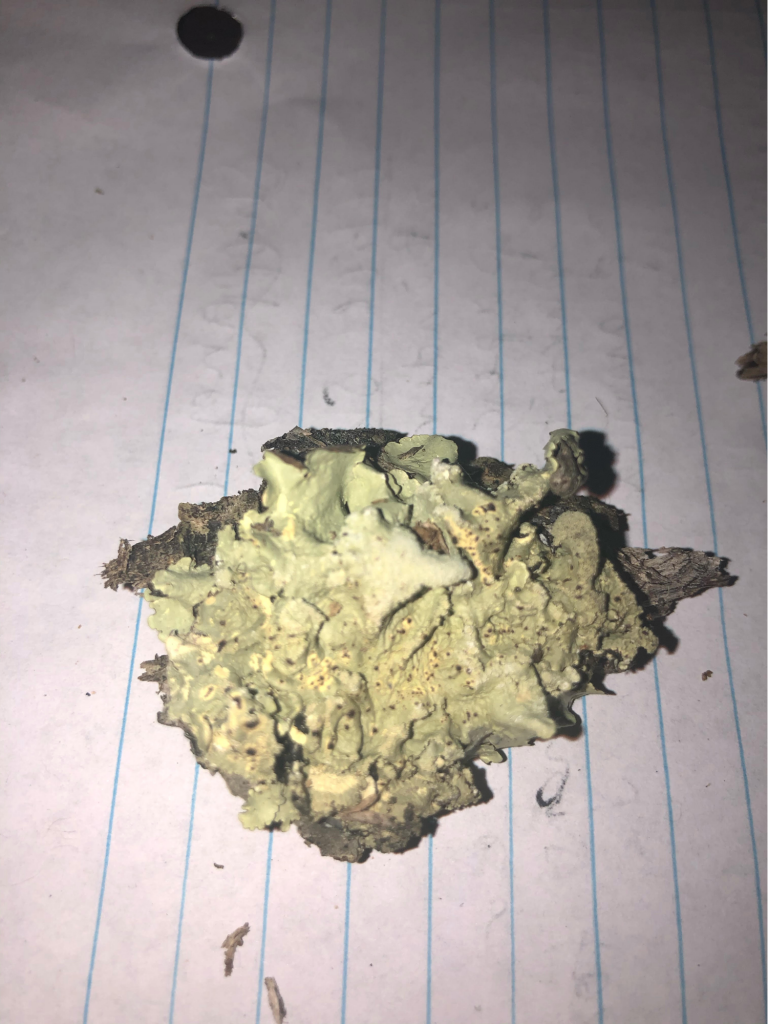
Greenshield lichen 
Old man’s beard lichen 
Reindeer lichen 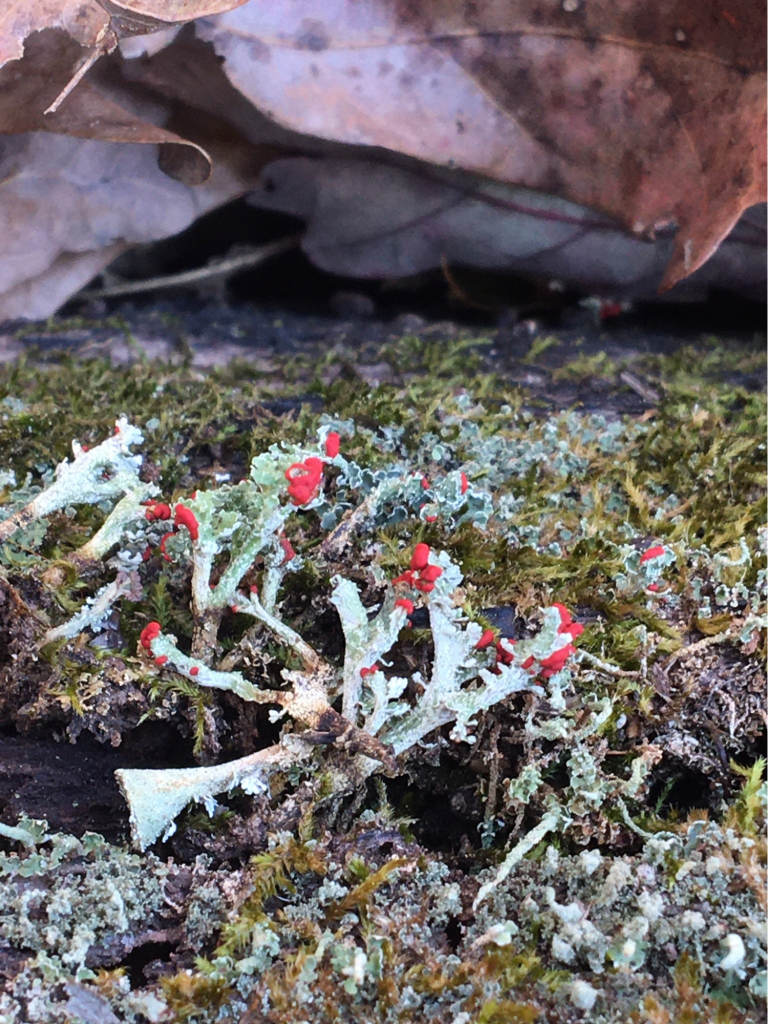
British soliders lichen 
Powdered ruffle lichen 
Pixie cups lichen
A lot of people think lichen is moss. But moss is a completely different organism. Here’s a picture of moss. Can you tell the difference?
Moss is a plant, with roots, leaves and stems. But a lichen is not a plant at all!
Lichen is actually part algae and part fungus*. These two organisms join together and live like one! It’s a little like Frankenstein’s monster
, except helpful instead of scary. When two organisms work together like this, it’s called symbiosis.
What is the algae’s job in the lichen? The algae makes its own food from the sun (also known as photosynthesis). The algae shares this food with its partner fungus.
The fungus’ job is making the lichen’s structure. Like a house, it gives the algae a safe place to live.
Do you think lichens are producers, decomposers, or consumers in the food web? Why?
Lichens do not have stems, roots, or leaves to move water, air and food around. Instead, lichens use all the cells in their body to breathe, eat and drink. They breathe in EVERYTHING that surrounds them. This makes them very sensitive to the air around them, like Goldilocks. Certain lichens can only grow in very clean, very filtered air, while others can handle harsher conditions.
Because they are so sensitive, scientists use lichens as bio-indicators–a living thing that shows how healthy their environment is. The number, health and kinds of lichen we find give us clues about how healthy the whole ecosystem is.
In North America, 3,600 species of lichen have been discovered so far! More are being discovered every day.
Using what you know about lichens so far, why do you think they are so important to an ecosystem?
*It’s also part yeast, and maybe a few other things. We are still learning what is in lichen!
Masters of Survival
Lichens need a lot of water. They are typically found near water, or north in areas that get a lot of fog. When lichens are wet, they photosynthesize and grow. When dry, they stop doing everything: no making food, no growing. This helps them save as much water as possible.

So when you spot a lichen outside, ask yourself: is it dry and brittle, or wet and spongy? The answer will tell you about how wet that place is. It might reflect recent weather. And it will tell you whether the lichen is active, or dormant!
Because they can turn themselves on and off, lichens are known as one of the toughest, hardiest organisms found in nature. They can live in extreme conditions: everywhere from the freezing arctic tundra to the blazing hot desert. In the arctic, lichens are the main producer feeding animals, because it’s so difficult for plants to survive there. This is because they can dry out when there isn’t water, and wait for water to return. Astronauts even put a dry lichen in outer space for two weeks, and it returned just fine!
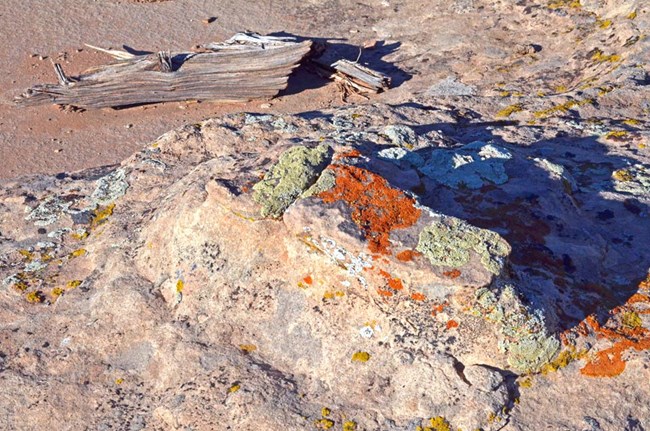
Because lichens don’t need roots to get nutrients, they can live on many more surfaces: you see them on rocks, concrete, dirt, and tree bark. In places that are very hard to grow–like rocks or places where volcanoes exploded–lichens might be the first organism to grow there. They prepare the ground before plants can grow. They have two parts that keep them attached to their surface. The first, rhizines, look like little twisty roots. The second, holdfasts, are often compared to an umbilical cord. They are just one thick structure that holds the entire lichen to its spot.
Lichens have a weak spot: they need very clean air to be healthy. Since they breathe in EVERYTHING in the air around them, you might not find them in polluted areas, like cities or near factories or power plants.
How do lichens help the ecosystem?
Many animals eat lichen. They can also use lichen as camouflage. Small birds, like the ruby-throated hummingbird, use them to build tiny nests that are hidden from predators. Gray tree frogs blend right in with them as well. The tree frogs will sit right on the lichen on the tree!
Humans use some lichens for dyes, medicine, and as a preservative. We are even able to eat certain types! Do you have a pool at your house? The small strips you use to test the pH of your water, litmus strips, are lined with the color-changing chemicals found in lichens.
Some animals that use lichens in our neck of the woods:
- Lacewing insect larvae (to live in)
- Northern Parula, ruby-throated hummingbird, and blue-gray gnatcatcher (for nests)
- Nuthatches and brown creepers (for food)
- Gray tree frogs (for camouflage)
- Flying squirrels (for food and nests)
Identifying lichen
There are three groups of lichen: Foliose, Fruticose, and Crustose. I can’t always identify what exact kind of lichen I’m looking at, but I can usually identify its group!
Foliose

Foliose lichen have 2 sides, like leaves on a tree. There is a top and bottom. They can be flat, leafy, or full of ridges and bumps.
Fruticose

Pixie cups lichen 
Old man’s beard
Fruticose lichen have more fruit-like shapes, rather than being flat like a leaf. They can go straight up and down, look almost hair-like and shrubby, or look like “cups.”
Crustose

Crustose are like their name: they look crusty
, and are often on rocks. They are flat and often have bright colors.With this information, what do you think is the most common kind of lichen in Ohio?
Your turn: Look for lichens
Now that you are an expert in the functioning of a lichen, go outside to try and find some!
- Look on trees, rocks, and other flat surfaces.
- Once you’ve spotted your lichen, try to figure out which of the three categories it belongs in: fruticose, crustose, or foliose. s it bright and colorful and flat? Or does it have bumps and ridges? What was it growing on?
- If you can’t find any–why do you think that is? If you find a bunch, what does that say about that environment?
After you’ve thought about these questions, share what you found in the comments! We’ll help you identify them!